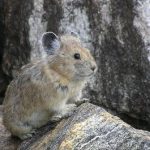Have you ever heard of the black-footed cat? If not, you’re missing out on one of the cutest animals in the world. This tiny feline is the smallest wild cat on the planet, weighing only about 2 kg and measuring about 40 cm in length. It has a round face, big ears and black spots on its fur that give it a charming appearance. But don’t let its size and cuteness fool you – this little cat is also one of the most fierce and successful hunters in the animal kingdom. Unfortunately, it is also one of the most endangered and threatened species, facing many challenges in its natural habitat. In this post, we’ll tell you everything you need to know about the black-footed cat and why it deserves more love and protection.
Where does the black-footed cat live?
The black-footed cat is native to southern Africa, where it inhabits arid and semi-arid regions such as grasslands, savannas and deserts. It prefers areas with sparse vegetation and rocky outcrops, where it can find shelter and prey. It avoids areas with dense cover or human activity, such as forests, wetlands and agricultural lands.
The black-footed cat is well adapted to its harsh environment. It has a thick coat that insulates it from the cold nights and a light color that camouflages it from predators and prey. It also has large ears that help it dissipate heat and hear better in the dark. It can survive without drinking water for long periods of time, getting most of its moisture from its food.
However, the black-footed cat also faces many threats in its habitat. One of the main ones is habitat loss due to human development, such as farming, mining and urbanization. This reduces the available space and resources for the cat and exposes it to more dangers, such as roads, fences and dogs. Another threat is poisoning, either intentional or accidental. Some farmers use poison baits to kill rodents or other pests, but these can also harm the cat if it eats them or their victims. Some people also kill the cat deliberately because they consider it a pest or a threat to their livestock, even though the cat rarely attacks domestic animals. A third threat is predation by larger carnivores, such as jackals, caracals and owls. The black-footed cat has few natural defenses against these predators and relies on its stealth and speed to escape.
What does the black-footed cat eat?
The black-footed cat is a nocturnal and solitary animal that hunts mostly at night. It has a varied diet that consists mainly of rodents, birds and insects. It can eat up to one-fifth of its body weight in a single night, which makes it one of the most efficient hunters in the world. It can catch up to 14 prey items per night, which is more than any other wild cat.
The black-footed cat has several hunting techniques that help it catch its prey. One of them is stalking, which involves creeping slowly and quietly towards its target until it is close enough to pounce. Another technique is pouncing, which involves jumping high into the air and landing on its prey with its sharp claws and teeth. A third technique is digging, which involves using its strong paws to dig out rodents or insects from their burrows or nests.
The black-footed cat also communicates with other cats using scent marks and vocalizations. It marks its territory with urine, feces or scratches to warn off intruders or attract mates. It also makes various sounds to express different emotions or intentions, such as purring, hissing, growling or meowing.
How does the black-footed cat reproduce?
The black-footed cat breeds once or twice a year, depending on the availability of food and water. The mating season usually occurs between July and March in the southern hemisphere. The male cat roams around looking for a female cat in heat, while the female cat stays in her home range waiting for a suitable mate. The male cat may fight with other males for access to a female cat.
The gestation period lasts about 63 days, after which the female cat gives birth to one to four kittens per litter. The kittens are born blind and helpless, weighing only about 60 g each. They are nursed by their mother for about two months until they are weaned. They start exploring their surroundings at about four weeks of age and learn how to hunt from their mother at about eight weeks of age. They become independent at about four months of age and reach sexual maturity at about one year of age.
The black-footed cat faces many challenges in its reproduction and lifespan. One of them is high infant
mortality, which can reach up to 70% in the first year of life. This is due to predation, disease, starvation or accidents. Another challenge is low genetic diversity, which reduces the ability of the cat to adapt to environmental changes or resist diseases. This is due to the small and isolated populations of the cat and the lack of gene flow between them. A third challenge is short lifespan, which averages about six years in the wild and up to 13 years in captivity. This is due to the harsh conditions and threats that the cat faces in its natural habitat.
Why should we care about the black-footed cat?
The black-footed cat is not only one of the cutest animals in the world, but also one of the most unique and fascinating ones. It has a remarkable hunting ability, a distinctive appearance and a complex behavior. It is also an important part of the ecosystem, as it helps control the populations of rodents and insects that can damage crops or spread diseases.
However, the black-footed cat is also one of the most endangered and threatened animals in the world. It is classified as vulnerable by the International Union for Conservation of Nature (IUCN), which means that it faces a high risk of extinction in the wild. It is estimated that there are only about 10,000 individuals left in the wild, and their numbers are declining rapidly.
The main reason for this decline is human activity, which destroys or degrades the habitat and resources of the cat and exposes it to more dangers and conflicts. If we don’t act soon to protect and conserve the black-footed cat, we may lose this amazing animal forever.
That’s why we should care about the black-footed cat and why it deserves more attention and conservation efforts. There are some organizations and projects that are working to save the black-footed cat, such as the Black-Footed Cat Working Group, the Black-Footed Cat Conservation Project and the Global Wildlife Conservation. They conduct research, education and outreach activities to raise awareness and support for the cat and its habitat. They also collaborate with local communities, governments and other stakeholders to implement effective conservation strategies and actions.
You can help these organizations and projects by donating money or time, spreading the word or adopting a black-footed cat. You can also help by reducing your environmental impact, supporting sustainable development and respecting wildlife. Every little action counts and can make a difference for the black-footed cat and other cute animals in the world.
Conclusion
The black-footed cat is one of the cutest animals in the world, but also one of the most endangered ones. It lives in arid and semi-arid regions of southern Africa, where it hunts mostly rodents, birds and insects. It breeds once or twice a year, producing one to four kittens per litter. It faces many threats in its habitat, such as habitat loss, poisoning and predation. It needs more love and protection from us humans, who are responsible for its decline. We should care about the black-footed cat and support its conservation efforts before it’s too late.
We hope you enjoyed this post about the black-footed cat and learned something new about this adorable animal. If you did, please share it with your friends and family who love cute animals too. And if you want to see more posts like this one, please subscribe to our newsletter or follow us on social media. Thank you for reading!


































